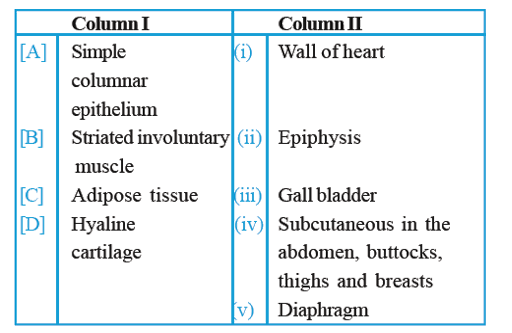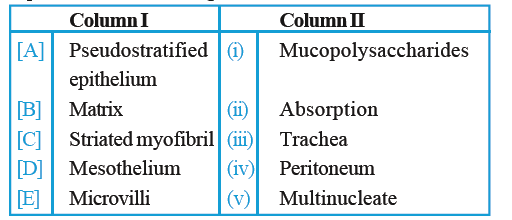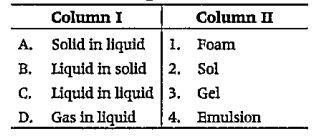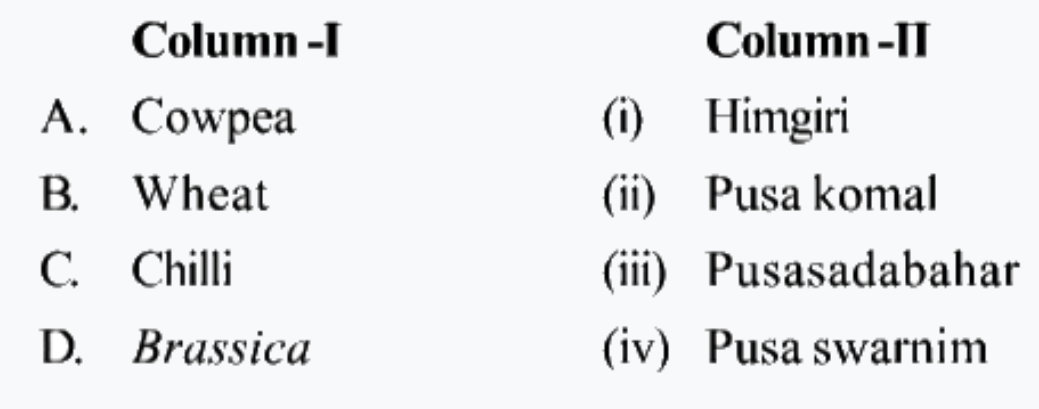Match the list of items of Column I with Column II and select the correct option from the codes given below.
Column IColumn IIA. Griffith(i) Lac operonB. Hershey and Chase(ii) Semi-conservative DNA replicationC. Messelson and Stahl(iii) Blender experimentD. Jacob and Monod(iv) Transformation
A-(iv), B-(iii), C-(ii), D-(i)
A-(iii), B-(iv), C-(ii), D-(i)
A-(iv), B-(ii), C-(iii), D-(i)
A-(ii), B-(i), C-(iii), D-(iv)
The correct Answer is:A
To solve the matching question, we will analyze each item in Column I and find the correct corresponding item in Column II based on the contributions of the scientists mentioned.
1. Identify the Contribution of Griffith (A):
- Frederick Griffith is known for his work on bacterial transformation. He conducted experiments with Streptococcus pneumoniae and discovered that non-virulent bacteria could be transformed into virulent forms by exposure to heat-killed virulent bacteria. This process is known as transformation.
- Match: A. Griffith → (iv) Transformation
2. Identify the Contribution of Hershey and Chase (B):
- Alfred Hershey and Martha Chase conducted the famous "Blender Experiment" in 1952. They used bacteriophages (viruses that infect bacteria) to demonstrate that DNA, not protein, is the genetic material. They labeled DNA and protein with different isotopes and used a blender to separate the viral components from the bacteria.
- Match: B. Hershey and Chase → (iii) Blender experiment
3. Identify the Contribution of Messelson and Stahl (C):
- Matthew Meselson and Franklin Stahl conducted an experiment that provided evidence for the semi-conservative model of DNA replication. They used isotopes of nitrogen to label DNA and showed that when DNA replicates, each new DNA molecule consists of one old strand and one newly synthesized strand.
- Match: C. Messelson and Stahl → (ii) Semi-conservative DNA replication
4. Identify the Contribution of Jacob and Monod (D):
- François Jacob and Jacques Monod are known for their work on the regulation of gene expression, particularly the lac operon in E. coli. They described how bacteria utilize lactose and the genetic mechanisms involved in this process.
- Match: D. Jacob and Monod → (i) Lac operon
Final Matches:
- A. Griffith → (iv) Transformation
- B. Hershey and Chase → (iii) Blender experiment
- C. Messelson and Stahl → (ii) Semi-conservative DNA replication
- D. Jacob and Monod → (i) Lac operon
Correct Option:
The correct matching sequence is:
- A → iv
- B → iii
- C → ii
- D → i
- Frederick Griffith is known for his work on bacterial transformation. He conducted experiments with Streptococcus pneumoniae and discovered that non-virulent bacteria could be transformed into virulent forms by exposure to heat-killed virulent bacteria. This process is known as transformation.
- Match: A. Griffith → (iv) Transformation
- Alfred Hershey and Martha Chase conducted the famous "Blender Experiment" in 1952. They used bacteriophages (viruses that infect bacteria) to demonstrate that DNA, not protein, is the genetic material. They labeled DNA and protein with different isotopes and used a blender to separate the viral components from the bacteria.
- Match: B. Hershey and Chase → (iii) Blender experiment
- Matthew Meselson and Franklin Stahl conducted an experiment that provided evidence for the semi-conservative model of DNA replication. They used isotopes of nitrogen to label DNA and showed that when DNA replicates, each new DNA molecule consists of one old strand and one newly synthesized strand.
- Match: C. Messelson and Stahl → (ii) Semi-conservative DNA replication
- François Jacob and Jacques Monod are known for their work on the regulation of gene expression, particularly the lac operon in E. coli. They described how bacteria utilize lactose and the genetic mechanisms involved in this process.
- Match: D. Jacob and Monod → (i) Lac operon
- A. Griffith → (iv) Transformation
- B. Hershey and Chase → (iii) Blender experiment
- C. Messelson and Stahl → (ii) Semi-conservative DNA replication
- D. Jacob and Monod → (i) Lac operon
The correct matching sequence is:
- A → iv
- B → iii
- C → ii
- D → i
Similar Questions
Knowledge Check
- Question 1 - Select One
Match Column I with Column II and select correct option from the codes given below.
 AA-(iii), B-(i), C-(ii), D-(iv)BA-(iii), B-(v), C-(iv), D-(ii)CA-(i), B-(iii), C-(iv), D-(v)DA-(iii), B-(i), C-(iv), D-(ii)
AA-(iii), B-(i), C-(ii), D-(iv)BA-(iii), B-(v), C-(iv), D-(ii)CA-(i), B-(iii), C-(iv), D-(v)DA-(iii), B-(i), C-(iv), D-(ii) - Question 2 - Select One
Match Column I with Column II and select the correct option from the codes given below.
 AA-(i), B-(ii), C-(iii), D-(iv)BA-(ii), B-(iii), C-(iv), D-(i)CA-(ii), B-(iv), C-(iii), D-(i)DA-(iv), B-(iii), C-(ii), D-(i)
AA-(i), B-(ii), C-(iii), D-(iv)BA-(ii), B-(iii), C-(iv), D-(i)CA-(ii), B-(iv), C-(iii), D-(i)DA-(iv), B-(iii), C-(ii), D-(i) - Question 3 - Select One
Match Column I with Column II and select the correct option from the codes given below.
 AA - (i), B - (ii), C-(iii), D - (iv)BA - (iv), B - (i), C-(ii), D- (iii)CA - (iv), B - (iii), C-(ii), D- (i)DA - (iii), B - (iv), C-(i), D - (ii)
AA - (i), B - (ii), C-(iii), D - (iv)BA - (iv), B - (i), C-(ii), D- (iii)CA - (iv), B - (iii), C-(ii), D- (i)DA - (iii), B - (iv), C-(i), D - (ii)
Match Column I with column II and select the correct option from the codes given below:
 View Solution
View SolutionMatch the Column I with Column II and select the correct option from the codes given below.
 View Solution
View SolutionMatch the Column I with Column II and select the correct option from the codes given below.
 View Solution
View SolutionMatch Column -I with Column -II and select the correct option from the codes given below.
 View Solution
View SolutionMatch column I with column II and select the correct option from the codes given below.
 View Solution
View Solution



